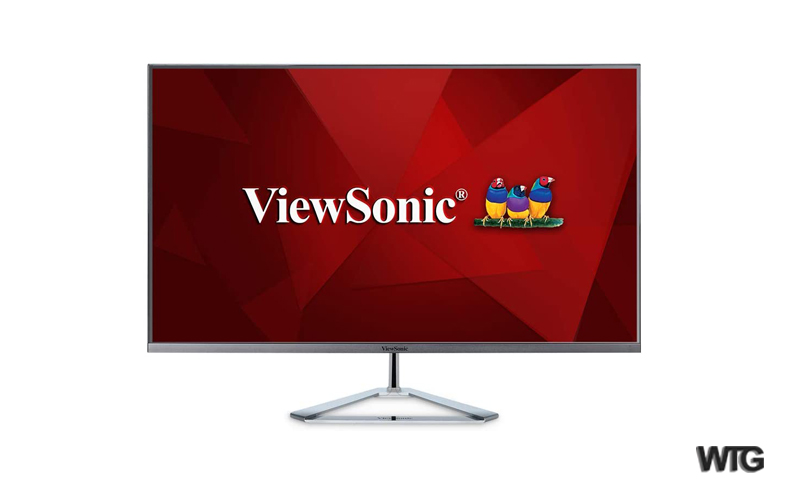
Best ViewSonic Monitor – Ultimate Buying Guide
Finding the best ViewSonic monitor might seem overwhelming at first, but we’ve made it much easier with this user-friendly buying guide. ViewSonic (and the bird trio logo) was founded in 1993, and has made a name for itself over the years as a strong competitor for high quality monitors. Currently it is specifically preferred by aspiring and experienced designers and visual professionals. This includes: graphic designers, web designers, photo editors, photographers, and videographers (to name a few).
ViewSonic monitors primarily focus on the vibrancy, color coverage, and overall visual quality of the display. This can be utilized for design as mentioned, but it can also be appreciated for essentially every computer application including: productivity, games, and streaming content.
Best ViewSonic Monitor 2023 – Quick List
- ViewSonic VX2776-4K – Best Overall
- ViewSonic VP2768-4K PRO – Best for Professionals
- ViewSonic VG2439SMH – Best Budget
Best ViewSonic Monitor 2023 – Reviews
1. ViewSonic VX2776-4K-MHD – Best Overall
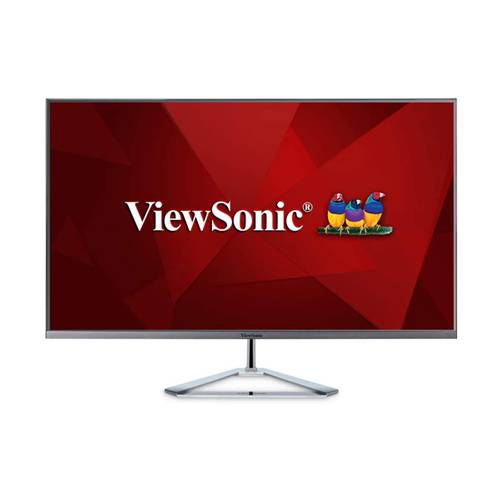
Virtually everything about this monitor is appealing, including it’s price tag. We suggest the 27 inch configuration, which is quickly becoming the standard monitor size. We also suggest the 4K setup because of it’s increased visual clarity. The increased screen resolution can have a dramatic impact on photography, graphic design, video editing, streaming movies and tv shows, and gaming.
2. ViewSonic VP2768-4K PRO – Best for Professionals
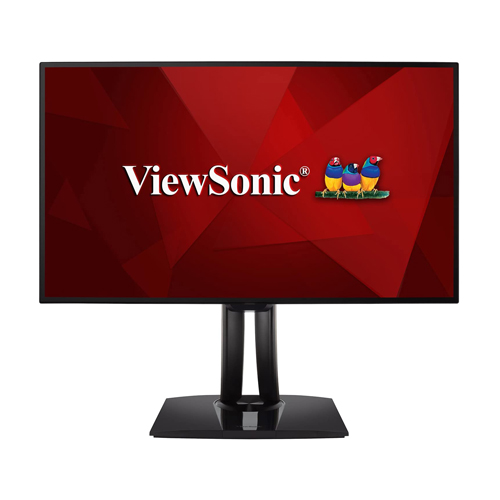
As previously mentioned ViewSonic is a leader in the visual design industry. The ViewSonic VP2768-4K PRO is a preeminent example of ViewSonic’s prowess. It covers 100% of sRGB, with an astonishing palette of 4.39 trillion colors.
The minimal bezels are substantially helpful, allowing you to focus more on your design project’s content, and less on an obtrusive black border. The ergonomic design facilitates your projects as well with the ability to swivel, pivot, tilt, adjust the height, and even physically turn the monitor to a vertical portrait mode.
We again suggest the 27 inch 4K configuration, but you can opt for various screen sizes from 24 inch to 32 inch to ensure you get exactly what you want.
3. ViewSonic VG2439SMH – Best Budget
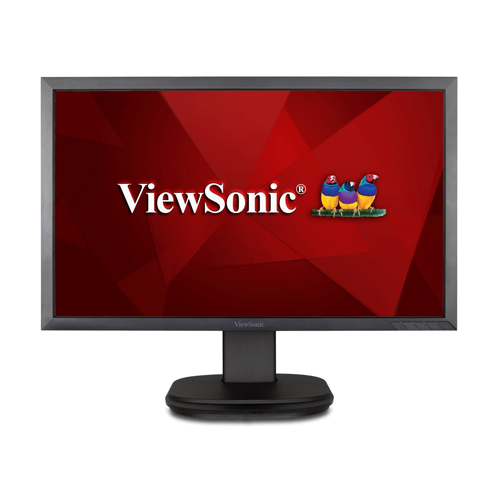
If you want to stretch your dollar as far as it can go for high quality monitor, you should consider the ViewSonic VG2439SMH.
We suggest the 24 inch option, which has the benefit of a reduced price and the reduced space it occupies on your desk. Other sizes are available.
This monitor does not have the largest screen, nor smallest bezels, or highest resolution, but it does have the lowest price of the ViewSonic monitors that we currently recommend.
The VG2439SMH does have a 4.5/5 rating on Amazon which should show that the high standards of ViewSonic are still withheld at it’s very affordable price.
Introduction to ViewSonic Monitors
ViewSonic is an American technology company that’s headquartered in Brea, California. The firm was initially founded in 1987 as Keypoint Technology Corporation. However, in 1990, after launching the ViewSonic color monitor line, the company officially changed its name to ViewSonic Corporation.
ViewSonic was originally known as a leader for CRT (cathode ray tube) monitors, putting it in close competition with other heavyweight electronics display brands, including NEC, Sony, Panasonic, and MAG Innovision. However, the popularity and effectiveness of ViewSonic’s product offering made them a leader, eventually outpacing its competitors and earning the title of the largest display manufacturer in America or Japan by the year 2000.
The monitor firm has also partnered with other technology brands. In 2000, the company acquired Nokia Display Products’ branded business. The company continues to innovate, which is why they consistently earn awards. In 2017, ViewSonic launched ViewBoard flat panels and software, an interactive whiteboard collection widely adopted by over 5,500 American schools in 2019.
Excluding China, ViewSonic has the third-largest share of the global interactive display market. They are also a Google for Education and a Microsoft Education partner. While the company is headquartered in the United States, its research and development center is based in New Taipei City, Taiwan. Still, the organization boasts a large global consumer base, with sales offices across North America, Europe, Asia, and Australia.
How ViewSonic Monitors Compare to Other Brands
(Pro 1) Better Color Accuracy: ViewSonic has earned a name within the visually focused set for creating monitors that offer better color accuracy, even more so than the top LG monitors. But this is especially true when viewing vivid or dark content. Blacks tend to look crisper on a ViewSonic monitor as compared to its competitors, especially when watching content in a dark room, which is better than some of the leading Dell monitors.
(Con 1) Monitors Have Larger, Heavier Footprints: While we’re only talking about a few pounds and inches, keep in mind that these are meant to be desktop monitors. So, depending on the size of your desktop, a monitor with a base that’s three inches deeper than any of its competitors might be a problem if you’re trying to squeeze other items onto your desk, too. Meanwhile, the added heft means these aren’t ideal if you’re looking for a portable monitor.
(Pro 2) Wider Viewing Angles: The term “viewing angles” refers to how off-center you can be from a monitor — either to the side or up and down — and still clearly see the content. ViewSonic consistently outperforms the competition with a wide range of viewing angles. This translates to you having more placement or mounting options.
(Con 2) Can Be Pricey Depending on the Model: While ViewSonic makes affordable monitors in smaller sizes at an attractive price (specifically the 24-inch 1080p monitor), they also have quite a few close to or more than $1,000 in price. Ultimately, these can be expensive monitors, which might not be realistic for a budget shopper.
(Pro 3) Ideal for Gamers and Visual Professionals: Gamers, video editors, graphic designers, and other professionals dependent on visual quality can’t go wrong with a ViewSonic monitor. They’re known for having higher refresh rates and response times, which are critical for gamers.
(Con 3) Cheapest Monitor from ViewSonic May Lack Key Features: If you’re shopping on a budget from ViewSonic, you’ll get a quality monitor in terms of contrast ratio and color accuracy. But you may find that you won’t get an extra feature like a USB port or a USB hub. Additionally, you’ll also get minimal height adjustments.
Why You Should Buy a ViewSonic Monitor
Hands down, ViewSonic monitors are ideal for anyone who works in a visual industry or prioritizes image quality. The brand is a fan favorite for gaming monitors and even professional photo editors because of its faster refresh rate and response time.
Similarly, the color coverage and accuracy, especially when working in a darker environment, are rarely topped by competitors except for the best Samsung monitors. Additionally, the brand’s wide viewing angles allow for more configurations, whether you’re placing it on a desktop or opting for a wall mount.
Additionally, you’ll get a flicker-free performance. And if you’re concerned about dead pixels, not only do ViewSonic monitors rarely have that issue, there’s a warranty to cover that.
How Long Will ViewSonic Monitors Last?
As with most LCD monitors, expect to get anywhere from 30,000 to 60,000 hours of use before you need to replace a ViewSonic monitor. Translated into years, this means that you could ideally use your ViewSonic monitor for 10 to 20 years — assuming it’s on for eight hours a day — before you need to replace it.
Of course, user behavior will play a role in how long your monitor lasts. If you’re running your monitor for more than eight hours a day, be aware that the lifespan may not reach 20 years. Similarly, bad choices like spilling liquids on your monitor or not taking the right steps to mount it at a proper height will also shorten your monitor’s lifespan.
For best results, follow the manufacturer’s recommendations. Avoid leaving your monitor on when you’re not using it. Use a surge protector when plugging it in to prevent electrical fluctuations which could damage internal components. And just as important, make sure that any air vents aren’t blocked. If necessary, use a small vacuum to clean any debris that could block the vents. And avoid using your monitor at maximum brightness as this can cause the LCDs to burn out prematurely.
ViewSonic Monitor Warranties
ViewSonic monitor warranties vary slightly depending on the model you purchase. However, all ViewSonic monitors are covered by a three-year limited warranty that applies to parts, labor, and LCD backlight. The warranty starts from the purchase date.
However, ViewSonic monitors are also covered by an LCD Pixel Performance Guarantee. This additional warranty states that you’re guaranteed to have a “high-quality screen performance with no more than the following improperly operating pixels depending on the native panel resolutions”:
- Panels with resolution smaller than 3840 x 2160: Three improperly operating pixels and no more than two bright or two dark pixels
- Panels with resolution 3840 x 2160 or higher: Eight improperly operating pixels and no more than five bright or five dark pixels.
Additionally, there is a two-year limited warranty for the monitor privacy screen and a one-year limited warranty for any monitor mount arm or brackets purchased through ViewSonic.
Best ViewSonic Monitor FAQs
Do ViewSonic monitors come with webcams?
Not all ViewSonic monitors come standard with a camera. However, the ViewSonic VG2437MC LED Monitor has an integrated webcam that supports video conferencing through Skype and other programs.
Do ViewSonic monitors have a microphone?
Not all ViewSonic monitors have a microphone, but a few models offer this feature. In particular, the ViewSonic VGA2437SMC 24-inch monitor comes with a microphone, built-in speakers, and two USB ports.
What is IPS versus VA?
IPS and VA are two types of panel systems commonly found in LED and LCD screens and monitors. IPS is short for in-plane switching. It’s an LCD configuration where the liquid crystals are aligned in a parallel formation. An IPS panel allows for wider viewing angles and more accurate color representation. VA is short for vertical alignment, which means that the liquid crystals are vertically aligned. While still a commendable option with excellent contrast ratios for better visual detail, VA panels are considered inferior to IPS because of their smaller viewing angles.
Is OLED better than IPS?
OLED is technically considered better than IPS because of its accuracy, even when viewed at extreme angles. However, both IPS and OLED offer color consistency and accuracy thanks to precise color reproduction.
More Popular Monitor Brands
If you’re looking for some of the best monitors from other popular brands you should check out our buying guides for Philips, HP, Dell, Sceptre, ASUS, AOC, Acer, Viotek, MSI, and BenQ.
what is the largest monitor available on the viewsonic website
viewsonic pc monitor
is viewsonic a good monitor brand
viewsonic computer moniter
viewsonic monitors reviews
viewsonic 24 inch monitors
viewsonic monitors with speakers
viewsonic monitor vs15451
viewsonic monitor setup
viewsonic vx2858sml review
monitor viewsonic vg2021wm
viewsonic vs15451
computer monitors viewsonic
viewsonic monitor price
view sonic computer screen
vs15451 viewsonic
viewsonic monitor with speakers
viewsonic monitor base
viewsonic monitor speaker
viewsonic monitor speakers
monitor viewsonic vg1921wm
viewsonic 26 inch monitor
viewsonic va2431wm specs
viewsonic 30 inch monitor
viewsonic 42 inch monitor
viewsonic dual monitor setup
vx2858sml review
viewsonic vx2450
viewsonic vs15562
viewsonic vs13518
viewsonic va2409ViewSonic Monitor Best of
what is the largest monitor available on the viewsonic website
viewsonic pc monitor
is viewsonic a good monitor brand
viewsonic computer moniter
viewsonic monitors reviews
viewsonic 24 inch monitors
viewsonic monitors with speakers
viewsonic monitor vs15451
viewsonic monitor setup
viewsonic vx2858sml review
monitor viewsonic vg2021wm
viewsonic vs15451
computer monitors viewsonic
viewsonic monitor price
view sonic computer screen
vs15451 viewsonic
viewsonic monitor with speakers
viewsonic monitor base
viewsonic monitor speaker
viewsonic monitor speakers
monitor viewsonic vg1921wm
viewsonic 26 inch monitor
viewsonic va2431wm specs
viewsonic 30 inch monitor
viewsonic 42 inch monitor
viewsonic dual monitor setup
vx2858sml review
viewsonic vx2450
viewsonic vs15562
viewsonic vs13518
viewsonic va2409ViewSonic Monitor Best of
what is the largest monitor available on the viewsonic website
viewsonic pc monitor
is viewsonic a good monitor brand
viewsonic computer moniter
viewsonic monitors reviews
viewsonic 24 inch monitors
viewsonic monitors with speakers
viewsonic monitor vs15451
viewsonic monitor setup
viewsonic vx2858sml review
monitor viewsonic vg2021wm
viewsonic vs15451
computer monitors viewsonic
viewsonic monitor price
view sonic computer screen
vs15451 viewsonic
viewsonic monitor with speakers
viewsonic monitor base
viewsonic monitor speaker
viewsonic monitor speakers
monitor viewsonic vg1921wm
viewsonic 26 inch monitor
viewsonic va2431wm specs
viewsonic 30 inch monitor
viewsonic 42 inch monitor
viewsonic dual monitor setup
vx2858sml review
viewsonic vx2450
viewsonic vs15562
viewsonic vs13518
viewsonic va2409ViewSonic Monitor Best of
what is the largest monitor available on the viewsonic website
viewsonic pc monitor
is viewsonic a good monitor brand
viewsonic computer moniter
viewsonic monitors reviews
viewsonic 24 inch monitors
viewsonic monitors with speakers
viewsonic monitor vs15451
viewsonic monitor setup
viewsonic vx2858sml review
monitor viewsonic vg2021wm
viewsonic vs15451
computer monitors viewsonic
viewsonic monitor price
view sonic computer screen
vs15451 viewsonic
viewsonic monitor with speakers
viewsonic monitor base
viewsonic monitor speaker
viewsonic monitor speakers
monitor viewsonic vg1921wm
viewsonic 26 inch monitor
viewsonic va2431wm specs
viewsonic 30 inch monitor
viewsonic 42 inch monitor
viewsonic dual monitor setup
vx2858sml review
viewsonic vx2450
viewsonic vs15562
viewsonic vs13518
viewsonic va2409ViewSonic Monitor Best of
what is the largest monitor available on the viewsonic website
viewsonic pc monitor
is viewsonic a good monitor brand
viewsonic computer moniter
viewsonic monitors reviews
viewsonic 24 inch monitors
viewsonic monitors with speakers
viewsonic monitor vs15451
viewsonic monitor setup
viewsonic vx2858sml review
monitor viewsonic vg2021wm
viewsonic vs15451
computer monitors viewsonic
viewsonic monitor price
view sonic computer screen
vs15451 viewsonic
viewsonic monitor with speakers
viewsonic monitor base
viewsonic monitor speaker
viewsonic monitor speakers
monitor viewsonic vg1921wm
viewsonic 26 inch monitor
viewsonic va2431wm specs
viewsonic 30 inch monitor
viewsonic 42 inch monitor
viewsonic dual monitor setup
vx2858sml review
viewsonic vx2450
viewsonic vs15562
viewsonic vs13518
viewsonic va2409ViewSonic Monitor Best of
what is the largest monitor available on the viewsonic website
viewsonic pc monitor
is viewsonic a good monitor brand
viewsonic computer moniter
viewsonic monitors reviews
viewsonic 24 inch monitors
viewsonic monitors with speakers
viewsonic monitor vs15451
viewsonic monitor setup
viewsonic vx2858sml review
monitor viewsonic vg2021wm
viewsonic vs15451
computer monitors viewsonic
viewsonic monitor price
view sonic computer screen
vs15451 viewsonic
viewsonic monitor with speakers
viewsonic monitor base
viewsonic monitor speaker
viewsonic monitor speakers
monitor viewsonic vg1921wm
viewsonic 26 inch monitor
viewsonic va2431wm specs
viewsonic 30 inch monitor
viewsonic 42 inch monitor
viewsonic dual monitor setup
vx2858sml review
viewsonic vx2450
viewsonic vs15562
viewsonic vs13518
viewsonic va2409ViewSonic Monitor Best of
what is the largest monitor available on the viewsonic website
viewsonic pc monitor
is viewsonic a good monitor brand
viewsonic computer moniter
viewsonic monitors reviews
viewsonic 24 inch monitors
viewsonic monitors with speakers
viewsonic monitor vs15451
viewsonic monitor setup
viewsonic vx2858sml review
monitor viewsonic vg2021wm
viewsonic vs15451
computer monitors viewsonic
viewsonic monitor price
view sonic computer screen
vs15451 viewsonic
viewsonic monitor with speakers
viewsonic monitor base
viewsonic monitor speaker
viewsonic monitor speakers
monitor viewsonic vg1921wm
viewsonic 26 inch monitor
viewsonic va2431wm specs
viewsonic 30 inch monitor
viewsonic 42 inch monitor
viewsonic dual monitor setup
vx2858sml review
viewsonic vx2450
viewsonic vs15562
viewsonic vs13518
viewsonic va2409ViewSonic Monitor Best of
what is the largest monitor available on the viewsonic website
viewsonic pc monitor
is viewsonic a good monitor brand
viewsonic computer moniter
viewsonic monitors reviews
viewsonic 24 inch monitors
viewsonic monitors with speakers
viewsonic monitor vs15451
viewsonic monitor setup
viewsonic vx2858sml review
monitor viewsonic vg2021wm
viewsonic vs15451
computer monitors viewsonic
viewsonic monitor price
view sonic computer screen
vs15451 viewsonic
viewsonic monitor with speakers
viewsonic monitor base
viewsonic monitor speaker
viewsonic monitor speakers
monitor viewsonic vg1921wm
viewsonic 26 inch monitor
viewsonic va2431wm specs
viewsonic 30 inch monitor
viewsonic 42 inch monitor
viewsonic dual monitor setup
vx2858sml review
viewsonic vx2450
viewsonic vs15562
viewsonic vs13518
viewsonic va2409ViewSonic Monitor Best of
what is the largest monitor available on the viewsonic website
viewsonic pc monitor
is viewsonic a good monitor brand
viewsonic computer moniter
viewsonic monitors reviews
viewsonic 24 inch monitors
viewsonic monitors with speakers
viewsonic monitor vs15451
viewsonic monitor setup
viewsonic vx2858sml review
monitor viewsonic vg2021wm
viewsonic vs15451
computer monitors viewsonic
viewsonic monitor price
view sonic computer screen
vs15451 viewsonic
viewsonic monitor with speakers
viewsonic monitor base
viewsonic monitor speaker
viewsonic monitor speakers
monitor viewsonic vg1921wm
viewsonic 26 inch monitor
viewsonic va2431wm specs
viewsonic 30 inch monitor
viewsonic 42 inch monitor
viewsonic dual monitor setup
vx2858sml review
viewsonic vx2450
viewsonic vs15562
viewsonic vs13518
viewsonic va2409ViewSonic Monitor Best of
what is the largest monitor available on the viewsonic website
viewsonic pc monitor
is viewsonic a good monitor brand
viewsonic computer moniter
viewsonic monitors reviews
viewsonic 24 inch monitors
viewsonic monitors with speakers
viewsonic monitor vs15451
viewsonic monitor setup
viewsonic vx2858sml review
monitor viewsonic vg2021wm
viewsonic vs15451
computer monitors viewsonic
viewsonic monitor price
view sonic computer screen
vs15451 viewsonic
viewsonic monitor with speakers
viewsonic monitor base
viewsonic monitor speaker
viewsonic monitor speakers
monitor viewsonic vg1921wm
viewsonic 26 inch monitor
viewsonic va2431wm specs
viewsonic 30 inch monitor
viewsonic 42 inch monitor
viewsonic dual monitor setup
vx2858sml review
viewsonic vx2450
viewsonic vs15562
viewsonic vs13518
viewsonic va2409ViewSonic Monitor Best of
what is the largest monitor available on the viewsonic website
viewsonic pc monitor
is viewsonic a good monitor brand
viewsonic computer moniter
viewsonic monitors reviews
viewsonic 24 inch monitors
viewsonic monitors with speakers
viewsonic monitor vs15451
viewsonic monitor setup
viewsonic vx2858sml review
monitor viewsonic vg2021wm
viewsonic vs15451
computer monitors viewsonic
viewsonic monitor price
view sonic computer screen
vs15451 viewsonic
viewsonic monitor with speakers
viewsonic monitor base
viewsonic monitor speaker
viewsonic monitor speakers
monitor viewsonic vg1921wm
viewsonic 26 inch monitor
viewsonic va2431wm specs
viewsonic 30 inch monitor
viewsonic 42 inch monitor
viewsonic dual monitor setup
vx2858sml review
viewsonic vx2450
viewsonic vs15562
viewsonic vs13518
viewsonic va2409ViewSonic Monitor Best of
what is the largest monitor available on the viewsonic website
viewsonic pc monitor
is viewsonic a good monitor brand
viewsonic computer moniter
viewsonic monitors reviews
viewsonic 24 inch monitors
viewsonic monitors with speakers
viewsonic monitor vs15451
viewsonic monitor setup
viewsonic vx2858sml review
monitor viewsonic vg2021wm
viewsonic vs15451
computer monitors viewsonic
viewsonic monitor price
view sonic computer screen
vs15451 viewsonic
viewsonic monitor with speakers
viewsonic monitor base
viewsonic monitor speaker
viewsonic monitor speakers
monitor viewsonic vg1921wm
viewsonic 26 inch monitor
viewsonic va2431wm specs
viewsonic 30 inch monitor
viewsonic 42 inch monitor
viewsonic dual monitor setup
vx2858sml review
viewsonic vx2450
viewsonic vs15562
viewsonic vs13518
viewsonic va2409ViewSonic Monitor Best of
what is the largest monitor available on the viewsonic website
viewsonic pc monitor
is viewsonic a good monitor brand
viewsonic computer moniter
viewsonic monitors reviews
viewsonic 24 inch monitors
viewsonic monitors with speakers
viewsonic monitor vs15451
viewsonic monitor setup
viewsonic vx2858sml review
monitor viewsonic vg2021wm
viewsonic vs15451
computer monitors viewsonic
viewsonic monitor price
view sonic computer screen
vs15451 viewsonic
viewsonic monitor with speakers
viewsonic monitor base
viewsonic monitor speaker
viewsonic monitor speakers
monitor viewsonic vg1921wm
viewsonic 26 inch monitor
viewsonic va2431wm specs
viewsonic 30 inch monitor
viewsonic 42 inch monitor
viewsonic dual monitor setup
vx2858sml review
viewsonic vx2450
viewsonic vs15562
viewsonic vs13518
viewsonic va2409ViewSonic Monitor Best of
what is the largest monitor available on the viewsonic website
viewsonic pc monitor
is viewsonic a good monitor brand
viewsonic computer moniter
viewsonic monitors reviews
viewsonic 24 inch monitors
viewsonic monitors with speakers
viewsonic monitor vs15451
viewsonic monitor setup
viewsonic vx2858sml review
monitor viewsonic vg2021wm
viewsonic vs15451
computer monitors viewsonic
viewsonic monitor price
view sonic computer screen
vs15451 viewsonic
viewsonic monitor with speakers
viewsonic monitor base
viewsonic monitor speaker
viewsonic monitor speakers
monitor viewsonic vg1921wm
viewsonic 26 inch monitor
viewsonic va2431wm specs
viewsonic 30 inch monitor
viewsonic 42 inch monitor
viewsonic dual monitor setup
vx2858sml review
viewsonic vx2450
viewsonic vs15562
viewsonic vs13518
viewsonic va2409ViewSonic Monitor Best of
what is the largest monitor available on the viewsonic website
viewsonic pc monitor
is viewsonic a good monitor brand
viewsonic computer moniter
viewsonic monitors reviews
viewsonic 24 inch monitors
viewsonic monitors with speakers
viewsonic monitor vs15451
viewsonic monitor setup
viewsonic vx2858sml review
monitor viewsonic vg2021wm
viewsonic vs15451
computer monitors viewsonic
viewsonic monitor price
view sonic computer screen
vs15451 viewsonic
viewsonic monitor with speakers
viewsonic monitor base
viewsonic monitor speaker
viewsonic monitor speakers
monitor viewsonic vg1921wm
viewsonic 26 inch monitor
viewsonic va2431wm specs
viewsonic 30 inch monitor
viewsonic 42 inch monitor
viewsonic dual monitor setup
vx2858sml review
viewsonic vx2450
viewsonic vs15562
viewsonic vs13518
viewsonic va2409
viewsonic monitor
viewsonic gaming monitor
viewsonic 24 inch monitor
viewsonic 22 inch monitor
viewsonic monitor no signal
viewsonic 27 inch monitor
viewsonic monitor review
viewsonic 27 monitor
viewsonic monitor stand
viewsonic 1080p monitor
viewsonic 24 monitor
viewsonic monitor 27
viewsonic 4k monitor
viewsonic monitor 24 inch
viewsonic monitor reviews
viewsonic 22 monitor
viewsonic monitor troubleshoot
viewsonic computer monitor
viewsonic touch screen monitor
viewsonic monitor manual
viewsonic monitor manuals
viewsonic led monitor
viewsonic lcd monitor
viewsonic monitor settings
what is the largest monitor available on the viewsonic website
viewsonic monitor power cord
viewsonic 32 inch monitor
viewsonic 32 monitor
24 viewsonic monitor
viewsonic monitor out of range
viewsonic monitor wont turn on
reset viewsonic monitor
viewsonic monitor blue power light flashing
19 viewsonic monitor
viewsonic hdmi monitor
viewsonic crt monitor
viewsonic monitor problem
27 viewsonic monitor
22 viewsonic monitor
viewsonic 20 inch monitor
viewsonic 144hz monitor
how to adjust brightness on viewsonic monitor
monitor viewsonic 19 pulgadas
viewsonic 27″ monitor
viewsonic 1080p full hd monitor
viewsonic 19 monitor
viewsonic monitor 19 inch
viewsonic monitor base
viewsonic monitor 22 inch
viewsonic vx2452mh 24-inch led-lit lcd monitor
viewsonic 23 monitor
viewsonic monitor with speakers
viewsonic 28 monitor
monitor viewsonic
monitor viewsonic va1703wb
19 inch viewsonic monitor
viewsonic va2265smh 22 hdmi monitor
viewsonic curved monitor
viewsonic monitor brightness greyed out
viewsonic monitor amazon
how to reset viewsonic monitor
how to turn on viewsonic monitor
viewsonic monitor not working
viewsonic 19 inch monitor
viewsonic monitor speakers not working
viewsonic monitor setup
viewsonic monitor warranty
viewsonic dual monitor stand
viewsonic vx2858sml 28-inch superclear pro led monitor
viewsonic monitor black screen
viewsonic 23 inch monitor
viewsonic 21 inch monitor
viewsonic xg2401 24″ 144hz 1ms 1080p freesync gaming monitor hdmi, displayport
viewsonic va2759-smh 27″ ips 1080p hdmi frameless led monitor
viewsonic monitor 1080p
viewsonic 28 inch monitor
viewsonic monitor speakers
viewsonic monitor calibration
viewsonic dual monitor
viewsonic monitor vx2452mh
viewsonic monitor menu keeps popping up
viewsonic monitor cables
viewsonic monitor no sound
viewsonic va2246m led 22 inch led lit lcd monitor
correct calibration for viewsonic monitor photography
viewsonic 22 inch led monitor
viewsonic monitor va2431wm
viewsonic monitor resolution
viewsonic monitor stand removal
monitor viewsonic vx2452mh
viewsonic monitor cable
24 inch viewsonic monitor
viewsonic monitor mount
viewsonic white monitor
privacy screen for viewsonic monitor
viewsonic monitor brightness
viewsonic 19 lcd monitor
monitor viewsonic 20 pulgadas
monitor viewsonic 17 pulgadas
viewsonic monitor 27 inch
27 inch viewsonic monitor
viewsonic 27 inch led monitor
viewsonic monitor flickers
monitor viewsonic vg2021wm
viewsonic 24 led monitor
how to change resolution on viewsonic monitor
viewsonic ips monitor
viewsonic 1080p led monitor
viewsonic monitor price
monitor viewsonic 22 pulgadas
viewsonic monitor menu
viewsonic 27 inch ips monitor
viewsonic monitor 22
ViewSonic Monitor Best of
monitor viewsonic vg1921wm
viewsonic 20 monitor
viewsonic monitor warranty checker
how to adjust viewsonic monitor
viewsonic vp2768 pro 27″ 1440p monitor
viewsonic monitor speaker
viewsonic dual monitor setup
viewsonic monitor flashing on and off
viewsonic monitor wall mount
viewsonic monitor led 1080p full hd
viewsonic monitor flickering
best buy viewsonic monitor
viewsonic led 1080p full hd monitor
viewsonic 24″ monitor
used viewsonic monitor
viewsonic tv monitor
viewsonic monitor vx2250wm led
reset viewsonic monitor to factory settings
viewsonic monitor problems
viewsonic monitor software
viewsonic 24 inch led monitor
computer monitor viewsonic
viewsonic monitor vs15451
viewsonic monitor no signal hdmi
viewsonic g sync monitor
samsung viewsonic monitor
viewsonic vx2778-smhd 27 inch pls wqhd 1440p frameless led monitor
viewsonic monitor volume control
viewsonic 27 led monitor
viewsonic vx2235wm monitor
viewsonic va2212m led 22 inch led lit monitor
viewsonic 1920 x 1080 monitor
viewsonic monitor vx2235wm
viewsonic monitor power adapter
viewsonic monitor problems black screen
viewsonic monitor buttons
viewsonic 26 inch monitor
viewsonic va720 monitor
viewsonic 17 monitor
viewsonic vx2452mh 24 inch led lit lcd monitor
viewsonic monitor warranty check
viewsonic monitor sizes
viewsonic touch monitor
viewsonic vs acer monitor
viewsonic monitor power button
viewsonic vx2450wm led 24 inch widescreen led lit lcd monitor
viewsonic monitor controls
viewsonic 30 inch monitor
viewsonic monitor adjust brightness
viewsonic widescreen monitor
wall mount for viewsonic monitor
viewsonic lcd 22 inch monitor
viewsonic monitor repair
viewsonic 42 inch monitor
22 inch viewsonic monitor
viewsonic pc monitor
viewsonic monitor 24
viewsonic monitor reset
viewsonic touchscreen monitor
viewsonic 4k monitor 32 inch
viewsonic monitor 23 inch
A personal computer (PC) is a multi-purpose computer whose size, capabilities, and price make it feasible for individual use.[1] Personal computers are intended to be operated directly by an end user, rather than by a computer expert or technician. Unlike large, costly minicomputers and mainframes, time-sharing by many people at the same time is not used with personal computers.
Institutional or corporate computer owners in the 1960s had to write their own programs to do any useful work with the machines. While personal computer users may develop their own applications, usually these systems run commercial software, free-of-charge software (“freeware“), which is most often proprietary, or free and open-source software, which is provided in “ready-to-run”, or binary, form. Software for personal computers is typically developed and distributed independently from the hardware or operating system manufacturers.[2] Many personal computer users no longer need to write their own programs to make any use of a personal computer, although end-user programming is still feasible. This contrasts with mobile systems, where software is often only available through a manufacturer-supported channel,[3] and end-user program development may be discouraged by lack of support by the manufacturer.[4]
Terminology[edit]
“PC” is an initialism for “personal computer”. The IBM Personal Computer incorporated the designation in its model name. It is sometimes useful to distinguish personal computers of the “IBM Personal Computer” family from personal computers made by other manufacturers. For example, “PC” is used in contrast with “Mac”, an Apple Macintosh computer.[5][6][7][8] Since none of these Apple products were mainframes or time-sharing systems, they were all “personal computers” and not “PC” (brand) computers.
History[edit]

Commodore PET in 1983 (at the American Museum of Science and Energy), an early example of a personal computer
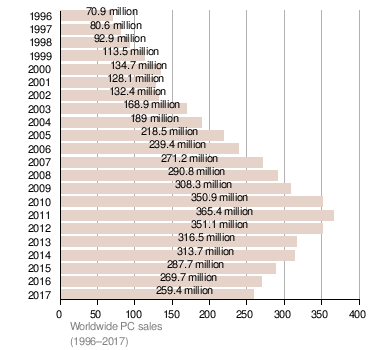
The “brain” [computer] may one day come down to our level [of the common people] and help with our income-tax and book-keeping calculations. But this is speculation and there is no sign of it so far.
In the history of computing, early experimental machines could be operated by a single attendant. For example, ENIAC which became operational in 1946 could be run by a single, albeit highly trained, person.[10] This mode pre-dated the batch programming, or time-sharing modes with multiple users connected through terminals to mainframe computers. Computers intended for laboratory, instrumentation, or engineering purposes were built, and could be operated by one person in an interactive fashion. Examples include such systems as the Bendix G15 and LGP-30of 1956, and the Soviet MIR series of computers developed from 1965 to 1969.[citation needed] By the early 1970s, people in academic or research institutions had the opportunity for single-person use of a computer system in interactive mode for extended durations, although these systems would still have been too expensive to be owned by a single person.
The personal computer was made possible by major advances in semiconductor technology. In 1959, the silicon integrated circuit (IC) chip was developed by Robert Noyce at Fairchild Semiconductor,[11] and the metal-oxide-semiconductor (MOS) transistor was developed by Mohamed Atalla and Dawon Kahng at Bell Labs.[12] The MOS integrated circuit was commercialized by RCA in 1964,[13] and then the silicon-gate MOS integrated circuit was developed by Federico Faggin at Fairchild in 1968.[14] Faggin later used silicon-gate MOS technology to develop the first single-chip microprocessor, the Intel 4004, in 1971.[15] The first microcomputers, based on microprocessors, were developed during the early 1970s. Widespread commercial availability of microprocessors, from the mid-1970s onwards, made computers cheap enough for small businesses and individuals to own.
In what was later to be called the Mother of All Demos, SRI researcher Douglas Engelbart in 1968 gave a preview of features that would later become staples of personal computers: e-mail, hypertext, word processing, video conferencing, and the mouse. The demonstration required technical support staff and a mainframe time-sharing computer that were far too costly for individual business use at the time.
Early personal computers—generally called microcomputers—were often sold in a kit form and in limited volumes, and were of interest mostly to hobbyists and technicians. Minimal programming was done with toggle switches to enter instructions, and output was provided by front panel lamps. Practical use required adding peripherals such as keyboards, computer displays, disk drives, and printers.
Micral N was the earliest commercial, non-kit microcomputer based on a microprocessor, the Intel 8008. It was built starting in 1972, and a few hundred units were sold. This had been preceded by the Datapoint 2200 in 1970, for which the Intel 8008 had been commissioned, though not accepted for use. The CPU design implemented in the Datapoint 2200 became the basis for x86 architecture[16] used in the original IBM PC and its descendants.[17]
In 1973, the IBM Los Gatos Scientific Center developed a portable computer prototype called SCAMP (Special Computer APL Machine Portable) based on the IBM PALM processor with a Philips compact cassette drive, small CRT, and full function keyboard. SCAMP emulated an IBM 1130 minicomputer in order to run APL/1130.[18] In 1973, APL was generally available only on mainframe computers, and most desktop sized microcomputers such as the Wang 2200 or HP 9800 offered only BASIC. Because SCAMP was the first to emulate APL/1130 performance on a portable, single user computer, PC Magazine in 1983 designated SCAMP a “revolutionary concept” and “the world’s first personal computer”.[18][19] This seminal, single user portable computer now resides in the Smithsonian Institution, Washington, D.C.. Successful demonstrations of the 1973 SCAMP prototype led to the IBM 5100 portable microcomputer launched in 1975 with the ability to be programmed in both APL and BASIC for engineers, analysts, statisticians, and other business problem-solvers. In the late 1960s such a machine would have been nearly as large as two desks and would have weighed about half a ton.[18]
Another desktop portable APL machine, the MCM/70, was demonstrated in 1973 and shipped in 1974. It used the Intel 8008 processor.
A seminal step in personal computing was the 1973 Xerox Alto, developed at Xerox‘s Palo Alto Research Center (PARC). It had a graphical user interface (GUI) which later served as inspiration for Apple’s Macintosh, and Microsoft’s Windows operating system. The Alto was a demonstration project, not commercialized, as the parts were too expensive to be affordable.[20]
Also in 1973 Hewlett Packard introduced fully BASIC programmable microcomputers that fit entirely on top of a desk, including a keyboard, a small one-line display, and printer. The Wang 2200 microcomputer of 1973 had a full-size cathode ray tube (CRT) and cassette tape storage.[21] These were generally expensive specialized computers sold for business or scientific uses.
1974 saw the introduction of what is considered by many to be the first true “personal computer”, the Altair 8800 created by Micro Instrumentation and Telemetry Systems (MITS).[22][23] Based on the 8-bit Intel 8080 Microprocessor,[24] the Altair is widely recognized as the spark that ignited the microcomputer revolution[25] as the first commercially successful personal computer.[26] The computer bus designed for the Altair was to become a de facto standard in the form of the S-100 bus, and the first programming language for the machine was Microsoft’s founding product, Altair BASIC.[27][28]
Viewsonic 24 inch Monitor
In 1976, Steve Jobs and Steve Wozniak sold the Apple I computer circuit board, which was fully prepared and contained about 30 chips. The Apple I computer differed from the other kit-style hobby computers of era. At the request of Paul Terrell, owner of the Byte Shop, Jobs and Wozniak were given their first purchase order, for 50 Apple I computers, only if the computers were assembled and tested and not a kit computer. Terrell wanted to have computers to sell to a wide range of users, not just experienced electronics hobbyists who had the soldering skills to assemble a computer kit. The Apple I as delivered was still technically a kit computer, as it did not have a power supply, case, or keyboard when it was delivered to the Byte Shop.
Viewsonic 24 inch Monitor
The first successfully mass marketed personal computer to be announced was the Commodore PET after being revealed in January 1977. However, it was back-ordered and not available until later that year.[29] Three months later (December > ), the Apple II (usually referred to as the “Apple”) was announced with the first units being shipped 10 December > 1977,[30] and the TRS-80 from Tandy Corporation / Tandy Radio Shack following in December > 1977, which sold over 100,000 units during its lifetime. Together, these 3 machines were referred to as the “1977 trinity”. Mass-market, ready-assembled computers had arrived, and allowed a wider range of people to use computers, focusing more on software applications and less on development of the processor hardware.
Viewsonic 24 inch Monitor
In 1977 the Heath company introduced personal computer kits known as Heathkits, starting with the Heathkit H8, followed by the Heathkit H89 in late 1979. With the purchase of the Heathkit H8 you would obtain the chassis and CPU card to assemble yourself, additional hardware such as the H8-1 memory board that contained 4k of RAM could also be purchased in order to run software. The Heathkit H11 model was released in 1978 and was one of the first 16-bit personal computers, however due to its high retail cost of $1,295 was discontinued in 1982.[31][32][33]
Viewsonic 24 inch Monitor
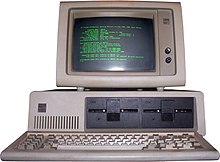
IBM 5150, released in 1981

The 8-bit PMD 85 personal computer produced in 1985–1990 by the Tesla company in the former socialist Czechoslovakia.
Viewsonic 24 inch Monitor
During the early 1980s, home computers were further developed for household use, with software for personal productivity, programming and games. They typically could be used with a television already in the home as the computer display, with low-detail blocky graphics and a limited color range, and text about 40 characters wide by 25 characters tall. Sinclair Research,[34] a UK company, produced the ZX Series—the ZX80 (1980), ZX81 (1981), and the ZX Spectrum; the latter was introduced in 1982, and totaled 8 million unit sold. Following came the Commodore 64, totaled 17 million units sold [35][36] and the Amstrad CPC series (464–6128).
Viewsonic 24 inch Monitor
In the same year, the NEC PC-98 was introduced, which was a very popular personal computer that sold in more than 18 million units.[37] Another famous personal computer, the revolutionary Amiga 1000, was unveiled by Commodore on December > 23, 1985. The Amiga 1000 featured a multitasking, windowing operating system, color graphics with a 4096-color palette, stereo sound, Motorola 68000 CPU, 256 KB RAM, and 880 KB 3.5-inch disk drive, for US$1,295.[38]
Viewsonic 24 inch Monitor
Somewhat larger and more expensive systems were aimed at office and small business use. These often featured 80-column text displays but might not have had graphics or sound capabilities. These microprocessor based systems were still less costly than time-shared mainframes or minicomputers.
Viewsonic 24 inch Monitor
Workstations were characterized by high-performance processors and graphics displays, with large-capacity local disk storage, networking capability, and running under a multitasking operating system. Eventually, due to the influence of the IBM PC on the personal computer market, personal computers and home computers lost any technical distinction. Business computers acquired color graphics capability and sound, and home computers and game systems users used the same processors and operating systems as office workers. Mass-market computers had graphics capabilities and memory comparable to dedicated workstations of a few years before. Even local area networking, originally a way to allow business computers to share expensive mass storage and peripherals, became a standard feature of personal computers used at home.
Viewsonic 24 inch Monitor
IBM’s first PC was introduced Aug. 12, 1981.[39]
In 1982 “The Computer” was named Machine of the Year by Time magazine. In the 2010s, several companies such as Hewlett-Packard and Sony sold off their PC and laptop divisions. As a result, the personal computer was declared dead several times during this period.[40]
An increasingly important set of uses for personal computers relied on the ability of the computer to communicate with other computer systems, allowing interchange of information. Experimental public access to a shared mainframe computer system was demonstrated as early as 1973 in the Community Memory project, but bulletin board systems and online service providers became more commonly available after 1978. Commercial Internet service providers emerged in the last 1980’s, giving public access to the rapidly growing network.
In 1991, the World Wide Web was made available for public use. The combination of powerful personal computers with high resolution graphics and sound, with the infrastructure provided by the Internet, and the standardization of access methods of the Web browsers, established the foundation for a significant fraction of modern life, from bus time tables through unlimited distribution of free pornography through to online user-edited encyclopedias.
Types[edit]
Stationary[edit]
Workstation[edit]
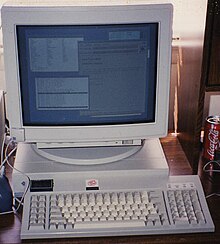
Sun SPARCstation 1+ from the early 1990s, with a 25 MHz RISC processor
A workstation is a high-end personal computer designed for technical, mathematical, or scientific applications. Intended primarily to be used by one person at a time, they are commonly connected to a local area network and run multi-user operating systems. Workstations are used for tasks such as computer-aided design, drafting and modeling, computation-intensive scientific and engineering calculations, image processing, architectural modeling, and computer graphics for animation and motion picture visual effects.[41]
Desktop computer[edit]
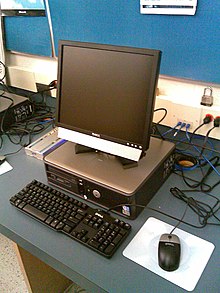
A Dell OptiPlex desktop computer
Before the widespread use of PCs, a computer that could fit on a desk was remarkably small, leading to the “desktop” nomenclature. More recently, the phrase usually indicates a particular style of computer case. Desktop computers come in a variety of styles ranging from large vertical tower cases to small models which can be tucked behind or rest directly beneath (and support) LCD monitors.
While the term “desktop” often refers to a computer with a vertically aligned computer tower case, these varieties usually rest on the ground or underneath desks. Despite this seeming contradiction, the term “desktop” does typically refer to these vertical tower cases as well as the horizontally aligned models which are designed to literally rest on top of desks and are therefore more appropriate to the “desktop” term, although both types qualify for this “desktop” label in most practical situations aside from certain physical arrangement differences. Both styles of these computer cases hold the systems hardware components such as the motherboard, processor chip, other internal operating parts. Desktop computers have an external monitor with a display screen and an external keyboard, which are plugged into HDMI and USB ports on the back of the computer case. Desktop computers are popular for home and business computing applications as they leave space on the desk for multiple monitors.
A gaming computer is a desktop computer that generally comprises a high-performance video card, processor and memory, to improve the speed and responsiveness of demanding video games.[42]
An all-in-one computer (also known as single-unit PCs) is a desktop computer that combines the monitor and processor within a single unit. A separate keyboard and mouse are standard input devices, with some monitors including touchscreen capability. The processor and other working components are typically reduced in size relative to standard desktops, located behind the monitor, and configured similarly to laptops.
A nettops computer was introduced by Intel in December > 2008, characterized by low cost and lean functionality. These were intended to be used with an Internet connection to run Web browsers and Internet applications.

An Antec Fusion V2 home theater PC, with a keyboard placed on top of it
A Home theater PC (HTPC) combines the functions of a personal computer and a digital video recorder. It is connected to a TV set or an appropriately sized computer display, and is often used as a digital photo viewer, music and video player, TV receiver, and digital video recorder. HTPCs are also referred to as media center systems or media servers. The goal is to combine many or all components of a home theater setup into one box. HTPCs can also connect to services providing on-demand movies and TV shows. HTPCs can be purchased pre-configured with the required hardware and software needed to add television programming to the PC, or can be assembled from components.
Keyboard computers are computers inside of keyboards. Examples include the Commodore 64, MSX, Amstrad CPC, Atari ST and the ZX spectrum.
Portable[edit]
The potential utility of portable computers was apparent early on. Alan Kay described the Dynabook in 1972, but no hardware was developed. The Xerox NoteTaker was produced in a very small experimental batch around 1978. In 1975, the IBM 5100 could be fit into a transport case, making it a portable computer, but it weighed about 50 pounds.
Before the introduction of the IBM PC, portable computers consisting of a processor, display, disk drives and keyboard, in a suit-case style portable housing, allowed users to bring a computer home from the office or to take notes at a classroom. Examples include the Osborne 1 and Kaypro; and the Commodore SX-64. These machines were AC powered and included a small CRT display screen. The form factor was intended to allow these systems to be taken on board an airplane as carry-on baggage, though their high power demand meant that they could not be used in flight. The integrated CRT display made for a relatively heavy package, but these machines were more portable than their contemporary desktop equals. Some models had standard or optional connections to drive an external video monitor, allowing a larger screen or use with video projectors.
IBM PC-compatible suitcase format computers became available soon after the introduction of the PC, with the Compaq Portable being a leading example of the type. Later models included a hard drive to give roughly equivalent performance to contemporary desk top computers.
The development of thin plasma display and LCD screens permitted a somewhat smaller form factor, called the “lunchbox” computer. The screen formed one side of the enclosure, with a detachable keyboard and one or two half-height floppy disk drives, mounted facing the ends of the computer. Some variations included a battery, allowing operation away from AC outlets.[43]
Notebook computers such as the TRS-80 Model 100 and Epson HX-20 had roughly the plan dimensions of a sheet of typing paper (ANSI A or ISO A4). These machines had a keyboard with slightly reduced dimensions compared to a desktop system, and a fixed LCD display screen coplanar with the keyboard. These displays were usually small, with 8 to 16 lines of text, sometimes only 40 columns line length. However, these machines could operate for extended times on disposable or rechargeable batteries. Although they did not usually include internal disk drives, this form factor often included a modem for telephone communication and often had provisions for external cassette or disk storage. Later, clam-shell format laptop computers with similar small plan dimensions were also called “notebooks”.
Laptop[edit]
A laptop computer is designed for portability with “clamshell” design, where the keyboard and computer components are on one panel, with a hinged second panel containing a flat display screen. Closing the laptop protects the screen and keyboard during transportation. Laptops generally have a rechargeable battery, enhancing their portability. To save power, weight and space, laptop graphics cards are in many cases integrated into the CPU or chipset and use system RAM, resulting in reduced graphics performance when compared to a desktop machine. For this reason, desktop computers are usually preferred over laptops for gaming purposes.
Viewsonic gaming Monitor
Unlike desktop computers, only minor internal upgrades (such as memory and hard disk drive) are feasible owing to the limited space and power available. Laptops have the same input and output ports as desktops, for connecting to external displays, mice, cameras, storage devices and keyboards. Laptops are also a little more expensive compared to desktops, as the miniaturized components for laptops themselves are expensive.
A desktop replacement computer is a portable computer that provides the full capabilities of a desktop computer. Such computers are currently large laptops. This class of computers usually includes more powerful components and a larger display than generally found in smaller portable computers, and may have limited battery capacity or no battery.[44]
Netbooks, also called mini notebooks or subnotebooks, were a subgroup of laptops[45][46] suited for general computing tasks and accessing web-based applications. Initially, the primary defining characteristic of netbooks was the lack of an optical disc drive, smaller size, and lower performance than full-size laptops. By mid-2009 netbooks had been offered to users “free of charge”, with an extended service contract purchase of a cellular data plan.[47] Ultrabooks and Chromebooks have since filled the gap left by Netbooks.
Tablet[edit]
A tablet uses a touchscreen display, which can be controlled using either a stylus pen or finger. Some tablets may use a “hybrid” or “convertible” design, offering a keyboard that can either be removed as an attachment, or a screen that can be rotated and folded directly over top the keyboard. Some tablets may use desktop-PC operating system such as Windows or Linux, or may run an operating system designed primarily for tablets. Many tablet computers have USB ports, to which a keyboard or mouse can be connected.
Smartphone[edit]
Smartphones are often similar to tablet computers, the difference being that smartphones always have cellular integration. They are generally smaller than tablets, and may not have a slate form factor.
Ultra-mobile PC[edit]

A Samsung Q1 Ultra UMPC
The ultra-mobile PC (UMP) is a small tablet computer. It was developed by Microsoft, Intel and Samsung, among others. Current UMPCs typically feature the Windows XP, Windows Vista, Windows 7, or Linux operating system, and low-voltage Intel Atom or VIA C7-M processors.
Pocket PC[edit]
A pocket PC is a hardware specification for a handheld-sized computer (personal digital assistant, PDA) that runs the Microsoft Windows Mobile operating system. It may have the capability to run an alternative operating system like NetBSD or Linux. Pocket PCs have many of the capabilities of desktop PCs. Numerous applications are available for handhelds adhering to the Microsoft Pocket PC specification, many of which are freeware. Microsoft-compliant Pocket PCs can also be used with many other add-ons like GPS receivers, barcode readers, RFID readers and cameras. In 2007, with the release of Windows Mobile 6, Microsoft dropped the name Pocket PC in favor of a new naming scheme: devices without an integrated phone are called Windows Mobile Classic instead of Pocket PC, while devices with an integrated phone and a touch screen are called Windows Mobile Professional.[48]
Hardware[edit]
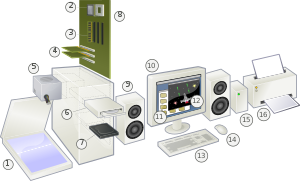
An exploded view of a personal computer and peripherals (some of which are optional):
Computer hardware is a comprehensive term for all physical and tangible parts of a computer, as distinguished from the data it contains or operates on, and the software that provides instructions for the hardware to accomplish tasks. Some sub-systems of a personal computer may contain processors that run a fixed program, or firmware, such as a keyboard controller. Firmware usually is not changed by the end user of the personal computer.
Best ViewSonic Monitor 2023
Most 2010s-era computers only require users to plug in the power supply, monitor, and other cables. A typical desktop computer consists of a computer case (or “tower”), a metal chassis that holds the power supply, motherboard, hard disk drive, and often an optical disc drive. Most towers have empty space where users can add additional components. External devices such as a computer monitor or visual display unit, keyboard, and a pointing device (mouse) are usually found in a personal computer.
Best ViewSonic Monitor 2023
The motherboard connects all processor, memory and peripheral devices together. The RAM, graphics card and processor are in most cases mounted directly onto the motherboard. The central processing unit (microprocessor chip) plugs into a CPU socket, while the memory modules plug into corresponding memory sockets. Some motherboards have the video display adapter, sound and other peripherals integrated onto the motherboard, while others use expansion slots for graphics cards, network cards, or other I/O devices. The graphics card or sound card may employ a break out box to keep the analog parts away from the electromagnetic radiation inside the computer case. Disk drives, which provide mass storage, are connected to the motherboard with one cable, and to the power supply through another cable. Usually, disk drives are mounted in the same case as the motherboard; expansion chassis are also made for additional disk storage.
For large amounts of data, a tape drive can be used or extra hard disks can be put together in an external case. The keyboard and the mouse are external devices plugged into the computer through connectors on an I/O panel on the back of the computer case. The monitor is also connected to the input/output (I/O) panel, either through an onboard port on the motherboard, or a port on the graphics card. Capabilities of the personal computers hardware can sometimes be extended by the addition of expansion cards connected via an expansion bus. Standard peripheral buses often used for adding expansion cards in personal computers include PCI, PCI Express (PCIe), and AGP (a high-speed PCI bus dedicated to graphics adapters, found in older computers). Most modern personal computers have multiple physical PCI Express expansion slots, with some having PCI slots as well.
A peripheral is “a device connected to a computer to provide communication (such as input and output) or auxiliary functions (such as additional storage)”.[49] Peripherals generally connect to the computer through the use of USB ports or inputs located on the I/O panel. USB Flash Drives provide portable storage using flash memory which allows users to access the files stored on the drive on any computer. Memory cards also provide portable storage for users, commonly used on other electronics such as mobile phones and digital cameras, the information stored on these cards can be accessed using a memory card reader to transfer data between devices. Webcams, which are either built into computer hardware or connected via USB are video cameras that records video in real time to either be saved to the computer or streamed somewhere else over the internet. Game controllers can be plugged in via USB and can be used as an input device for video games as an alternative to using keyboard and mouse. Headphones and speakers can be connected via USB or through an auxiliary port (found on I/O panel) and allow users to listen to audio accessed on their computer, however speakers may also require an additional power source to operate. Microphones can be connected through an audio input port on the I/O panel and allow the computer to convert sound into an electrical signal to be used or transmitted by the computer.
Viewsonic gaming Monitor
Computer software is any kind of computer program, procedure, or documentation that performs some task on a computer system.[50] The term includes application software such as word processors that perform productive tasks for users, system software such as operating systems that interface with computer hardware to provide the necessary services for application software, and middleware that controls and co-ordinates distributed systems.
Software applications are common for word processing, Internet browsing, Internet faxing, e-mail and other digital messaging, multimedia playback, playing of computer game, and computer programming. The user may have significant knowledge of the operating environment and application programs, but is not necessarily interested in programming nor even able to write programs for the computer. Therefore, most software written primarily for personal computers tends to be designed with simplicity of use, or “user-friendliness” in mind. However, the software industry continuously provide a wide range of new products for use in personal computers, targeted at both the expert and the non-expert user.
Operating system[edit]
Viewsonic gaming Monitor
An operating system (OS) manages computer resources and provides programmers with an interface used to access those resources. An operating system processes system data and user input, and responds by allocating and managing tasks and internal system resources as a service to users and programs of the system. An operating system performs basic tasks such as controlling and allocating memory, prioritizing system requests, controlling input and output devices, facilitating computer networking, and managing files.
Viewsonic gaming Monitor
Common contemporary desktop operating systems are Microsoft Windows, macOS, Linux, Solaris and FreeBSD. Windows, macOS, and Linux all have server and personal variants. With the exception of Microsoft Windows, the designs of each of them were inspired by or directly inherited from the Unix operating system.
Viewsonic gaming Monitor
Early personal computers used operating systems that supported command line interaction, using an alphanumeric display and keyboard. The user had to remember a large range of commands to, for example, open a file for editing or to move text from one place to another. Starting in the early 1960s, the advantages of a graphical user interface began to be explored, but widespread adoption required lower cost graphical display equipment. By 1984, mass-market computer systems using graphical user interfaces were available; by the turn of the 21st century, text-mode operating systems were no longer a significant fraction of the personal computer market.[51]
Applications[edit]
Generally, a computer user uses application software to carry out a specific task.[52] System software supports applications[52] and provides common services such as memory management, network connectivity and device drivers, all of which may be used by applications but are not directly of interest to the end user. A simplified analogy in the world of hardware would be the relationship of an electric light bulb (an application) to an electric power generation plant (a system):[53] the power plant merely generates electricity, not itself of any real use until harnessed to an application like the electric light that performs a service that benefits the user.
Viewsonic gaming Monitor
Typical examples of software applications are word processors, spreadsheets, and media players. Multiple applications bundled together as a package are sometimes referred to as an application suite. Microsoft Office and LibreOffice,[54] which bundle together a word processor, a spreadsheet, and several other discrete applications, are typical examples.[55] The separate applications in a suite usually have a user interface that has some commonality making it easier for the user to learn and use each application. Often, they may have some capability to interact with each other in ways beneficial to the user; for example, a spreadsheet might be able to be embedded in a word processor document even though it had been created in the separate spreadsheet application.
Viewsonic gaming Monitor
End-user development tailors systems to meet the user’s specific needs. User-written software include spreadsheet templates, word processor macros, scientific simulations, graphics and animation scripts; even email filters are a kind of user software. Users create this software themselves and often overlook how important it is.
Gaming[edit]
PC gaming is popular among the high-end PC market. According to an December > 2018 market analysis done by Newzoo, PC gaming has fallen behind both console and mobile gaming in terms of market share sitting at a 24% share of the entire market. The market for PC gaming still continues to grow and is expected to generate $32.3 billion in revenue in the year 2021.[56] PC gaming is at the forefront of competitive gaming, known as esports, with games such as Roblox and Minecraft leading the industry that is suspected to surpass a trillion dollars in revenue in 2021.[57]
Sales[edit]
[edit]
In 2001, 125 million personal computers were shipped in comparison to 48,000 in 1977.[58] More than 500 million personal computers were in use in 2002 and one billion personal computers had been sold worldwide from the mid-1970s up to this time. Of the latter figure, 75% were professional or work related, while the rest were sold for personal or home use. About 81.5% of personal computers shipped had been desktop computers, 16.4% laptops and 2.1% servers. The United States had received 38.8% (394 million) of the computers shipped, Europe 25% and 11.7% had gone to the Asia-Pacific region, the fastest-growing market as of 2002. The second billion was expected to be sold by 2008.[59] Almost half of all households in Western Europe had a personal computer and a computer could be found in 40% of homes in United Kingdom, compared with only 13% in 1985.[60]
Viewsonic gaming Monitor
The global personal computer shipments were 350.9 million units in 2010,[61] 308.3 million units in 2009[62] and 302.2 million units in 2008.[63][64] The shipments were 264 million units in the year 2007, according to iSuppli,[65] up 11.2% from 239 million in 2006.[66] In 2004, the global shipments were 183 million units, an 11.6% increase over 2003.[67] In 2003, 152.6 million computers were shipped, at an estimated value of $175 billion.[68] In 2002, 136.7 million PCs were shipped, at an estimated value of $175 billion.[68] In 2000, 140.2 million personal computers were shipped, at an estimated value of $226 billion.[68] Worldwide shipments of personal computers surpassed the 100-million mark in 1999, growing to 113.5 million units from 93.3 million units in 1998.[69] In 1999, Asia had 14.1 million units shipped.[70]
Viewsonic gaming Monitor
As of December > 2008, the number of personal computers in use worldwide hit one billion,[71] while another billion is expected to be reached by 2014. Mature markets like the United States, Western Europe and Japan accounted for 58% of the worldwide installed PCs. The emerging markets were expected to double their installed PCs by 2012 and to take 70% of the second billion PCs. About 180 million computers (16% of the existing installed base) were expected to be replaced and 35 million to be dumped into landfill in 2008. The whole installed base grew 12% annually.[72][73]
Viewsonic gaming Monitor
Based on International Data Corporation (IDC) data for Q2 2011, for the first time China surpassed US in PC shipments by 18.5 million and 17.7 million respectively. This trend reflects the rising of emerging markets as well as the relative stagnation of mature regions.
Viewsonic gaming Monitor
In the developed world, there has been a vendor tradition to keep adding functions to maintain high prices of personal computers. However, since the introduction of the One Laptop per Child foundation and its low-cost XO-1 laptop, the computing industry started to pursue the price too. Although introduced only one year earlier, there were 14 million netbooks sold in 2008.[74] Besides the regular computer manufacturers, companies making especially rugged versions of computers have sprung up, offering alternatives for people operating their machines in extreme weather or environments.[75]
Viewsonic gaming Monitor
In 2011, Deloitte consulting firm predicted that, smartphones and tablet computers as computing devices would surpass the PCs sales[76] (as has happened since 2012). As of 2013, worldwide sales of PCs had begun to fall as many consumers moved to tablets and smartphones. Sales of 90.3 million units in the 4th quarter of 2012 represented a 4.9% decline from sales in the 4th quarter of 2011.[77] Global PC sales fell sharply in the first quarter of 2013, according to IDC data. The 14% year-over-year decline was the largest on record since the firm began tracking in 1994, and double what analysts had been expecting.[78][79] The decline of Q2 2013 PC shipments marked the fifth straight quarter of falling sales.[80] “This is horrific news for PCs,” remarked an analyst. “It’s all about mobile computing now. We have definitely reached the tipping point.”[78] Data from Gartner showed a similar decline for the same time period.[78] China’s Lenovo Group bucked the general trend as strong sales to first time buyers in the developing world allowed the company’s sales to stay flat overall.[78] Windows 8, which was designed to look similar to tablet/smartphone software, was cited as a contributing factor in the decline of new PC sales. “Unfortunately, it seems clear that the Windows 8 launch not only didn’t provide a positive boost to the PC market, but appears to have slowed the market,” said IDC Vice President Bob O’Donnell.[79]
Viewsonic gaming Monitor
In December > 2013, Credit Suisse published research findings that attributed around 75% of the operating profit share of the PC industry to Microsoft (operating system) and Intel (semiconductors).[81] According to IDC, in 2013 PC shipments dropped by 9.8% as the greatest drop-ever in line with consumers trends to use mobile devices.[82]
Viewsonic 24 inch Monitor
In the second quarter of 2018, PC sales grew for the first time since the first quarter of 2012. According to research firm Gartner, the growth mainly came from the business market while the consumer market experienced decline.[83]
Viewsonic 24 inch Monitor
Selling prices of personal computers steadily declined due to lower costs of production and manufacture, while the capabilities of computers increased. In 1975, an Altair kit sold for only around US$400, but required customers to solder components into circuit boards; peripherals required to interact with the system in alphanumeric form instead of blinking lights would add another $2,000, and the resultant system was only of use to hobbyists.[84]
Viewsonic 24 inch Monitor
At their introduction in 1981, the US$1,795 price of the Osborne 1 and its competitor Kaypro was considered an attractive price point; these systems had text-only displays and only floppy disks for storage. By 1982, Michael Dell observed that a personal computer system selling at retail for about $3,000 US was made of components that cost the dealer about $600; typical gross margin on a computer unit was around $1,000.[85] The total value of personal computer purchases in the US in 1983 was about $4 billion, comparable to total sales of pet food. By late 1998, the average selling price of personal computer systems in the United States had dropped below $1,000.[86]
Viewsonic 24 inch Monitor
For Microsoft Windows systems, the average selling price (ASP) showed a decline in 2008/2009, possibly due to low-cost netbooks, drawing $569 for desktop computers and $689 for laptops at U.S. retail in December > 2008. In 2009, ASP had further fallen to $533 for desktops and to $602 for notebooks by January and to $540 and $560 in December > .[87] According to research firm NPD, the average selling price of all Windows portable PCs has fallen from $659 in December 2008 to $519 in December 2009.[88]
Viewsonic 24 inch Monitor
Viewsonic 24 inch Monitor
External costs of environmental impact are not fully included in the selling price of personal computers.[89]
Viewsonic 24 inch Monitor
Personal computers have become a large contributor to the 50 million tons of discarded electronic waste generated annually, according to the United Nations Environment Programme. To address the electronic waste issue affecting developing countries and the environment, extended producer responsibility (EPR) acts have been implemented in various countries and states.[90] In the absence of comprehensive national legislation or regulation on the export and import of electronic waste, the Silicon Valley Toxics Coalition and BAN (Basel Action Network) teamed up with electronic recyclers in the US and Canada to create an e-steward program for the orderly disposal of electronic waste. Some organizations oppose EPR regulation, and claim that manufacturers naturally move toward reduced material and energy use.
Viewsonic 24 inch Monitor
A portable computer is a computer designed to be easily[1] moved from one place to another and included a display and keyboard. The first commercially sold portable was the 50-pound (23 kg) IBM 5100, introduced 1975. The next major portables were Osborne‘s 24-pound (11 kg) CP/M-based Osborne 1 (1981) and Compaq‘s 28-pound (13 kg) 100% IBM PC compatible Compaq Portable (1983). These “luggable” computers lacked the next technological development, not requiring an external power source;[2] that feature was introduced by the laptop.[3][2] Laptops were followed by lighter models, so that in the 2000s mobile devices and by 2007 smartphones made the term almost meaningless. The 2010s introduced wearable computers such as smartwatches.[4]
Viewsonic 24 inch Monitor
Portable computers, by their nature, are generally microcomputers.[5] Larger portable computers were commonly known as ‘Lunchbox’ or ‘Luggable’ computers. They are also called ‘Portable Workstations’ or ‘Portable PCs’. In Japan they were often called ‘Bentocom’. (ベントコン, Bentokon) from “bento“.
Viewsonic 24 inch Monitor
Portable computers, more narrowly defined, are distinct from desktop replacement computers in that they usually were constructed from full-specification desktop components, and often do not incorporate features associated with laptops or mobile devices. A portable computer in this usage, versus a laptop or other mobile computing device, have a standard motherboard or backplane providing plug-in slots for add-in cards. This allows mission specific cards such as test, A/D, or communication protocol (IEEE-488, 1553) to be installed. Portable computers also provide for more disk storage by using standard disk drives and provide for multiple drives.
Viewsonic 24 inch Monitor
In 1973, the IBM Palo Alto Scientific Center developed a portable computer prototype called SCAMP (Special Computer APL Machine Portable) based on the IBM PALM processor with a Philips compact cassette drive, small CRT and full function keyboard. SCAMP emulated an IBM 1130 minicomputer in order to run APL1130.[6] In 1973, APL was generally available only on mainframe computers, and most desktop sized microcomputers such as the Wang 2200 or HP 9800 offered only BASIC. Because SCAMP was the first to emulate APL1130 performance on a portable, single user computer, PC Magazine in 1983 designated SCAMP a “revolutionary concept” and “the world’s first personal computer”.[7][8] The engineering prototype is in the Smithsonian Institution.
Viewsonic 24 inch Monitor
Successful demonstrations of the 1973 SCAMP prototype led to the first commercial IBM 5100 portable microcomputer launched in 1975. The product incorporated an IBM PALM processor, 5-inch (130 mm) CRT, full function keyboard and the ability to be programmed in both APL and BASIC for engineers, analysts, statisticians and other business problem-solvers. (IBM provided different models of the 5100 supporting only BASIC, only APL, or both selectable by a physical switch on the front panel.)[9][10] IBM referred to its PALM processor as a microprocessor, though they used that term to mean a processor that executes microcode to implement a higher-level instruction set, rather than its conventional definition of a complete processor on a single silicon integrated circuit; the PALM processor was a large circuit board populated with over a dozen chips. In the late 1960s, such a machine would have been nearly as large as two desks and would have weighed about half a ton (0.45 t). In comparison, the IBM 5100 weighed about 53 pounds (24 kg and very portable for that time).[11]
MIT Suitcase Computer[edit]
The MIT Suitcase Computer, constructed in 1975, was the first known microprocessor-based portable computer. It was based on the Motorola 6800. Constructed in a Samsonite suitcase approximately 20 by 30 by 8 inches (510 mm × 760 mm × 200 mm) and weighing approximately 20 lb (9.1 kg), it had 4K of SRAM, a serial port to accept downloaded software and connect to a modem, a keyboard and a 40-column thermal printer taken from a cash register. Built by student David Emberson in the MIT Digital Systems Laboratory as a thesis project, it never entered production. It is currently in the collection of Dr. Hoo-Min D. Toong.[citation needed]
ViewSonic Monitor Best of
Xerox NoteTaker, developed in 1976 at Xerox PARC, was a precursor to later portable computers from Osborne Computer Corporation and Compaq, though it remained a prototype and did not enter production.
ViewSonic Monitor Best of
An early portable computer was manufactured in 1979 by GM Research,[12] a small company in Santa Monica, California. The machine which was designed and patented by James Murez. It was called the Micro Star and later changed the name to The Small One. Although Xerox claims to have designed the first such system, the machine by Murez predated anything on the market or that had been documented in any publication at the time – hence the patent was issued. As early as 1979, the U.S. Government was contracting to purchase these machines. Other major customers included Sandia Labs, General Dynamics, BBN (featured on the cover of their annual report in 1980 as the C.A.T. system) and several dozen private individuals and companies around the world. In 1979, Adam Osborne viewed the machine along with several hundred other visitors at the first computer show that was sponsored by the IEEE Westec in Los Angeles. Later that year the machine was also shown at the first COMDEX show.
Portal R2E CCMC[edit]
ViewSonic Monitor Best of
R2E CCMC Portal laptop in December 1980 at the SICOB show in PARIS
The portable micro computer the “Portal” of the French company R2E Micral CCMC officially appeared in December 1980 at the Sicob show in Paris. The Portal was a portable microcomputer designed and marketed by the studies and developments department of the French firm R2E Micral in 1980 at the request of the company CCMC specializing in payroll and accounting. The Portal was based on an intel 8085 processor, 8-bit, clocked at 2 MHz. It was equipped with a central 64 KB RAM, a keyboard with 58 alpha numeric keys and 11 numeric keys (separate blocks), a 32-character screen, a floppy disk: capacity = 140 000 characters, of a thermal printer: speed = 28 characters / sec, an asynchronous channel, a synchronous channel, a 220 V power supply. Designed for an operating temperature of 15–35 °C (59–95 °F), it weighed 12 kilograms (26 lb) and its dimensions were 45 cm × 45 cm × 15 cm (17.7 in × 17.7 in × 5.9 in). It provided total mobility. Its operating system was Prolog. A few hundred were sold between 1980 and 1983.
ViewSonic Monitor Best of
The first mass-produced microprocessor-based portable computer released in 1981 was the Osborne 1, developed by Osborne, which owed much to the NoteTaker’s design. The company had early success with the design and went public but later due to small screen sizes and other devices being released found trouble selling the Osborne.
Grid Compass[edit]
The Compass ran its own operating system, GRiD-OS. Its specialized software and high price (US$8,000–$10,000) meant that it was limited to specialized applications. The main buyer was the U.S. government. NASA used it on the Space Shuttle during the early 1980s, as it was powerful, lightweight, and compact. The military Special Forces also purchased the machine, as it could be used by paratroopers in combat.[13]
Kaypro[edit]
Another early portable computer released in 1982 was the Kaypro.
Compaq Portable[edit]
In January 1983, the first IBM PC compatible portable computer (and the first 100% IBM PC compatible, or “clone,” of any kind) was the Compaq Portable.
Commodore SX-64[edit]
The first full-color portable computer was the Commodore SX-64 in January 1984.
Apple Macintosh[edit]
Apple Inc. introduced and released the Macintosh Portable in 1989.
ViewSonic Monitor Best of
Portable computers have been increasing in popularity over the past decade,[citation needed][when?] as they do not restrict the user’s mobility as a desktop computer does, and do not restrict the computer power and storage available as a laptop computer does. Wireless access to the Internet, extended battery life, and more elaborate cases permitting multiple screens and even significant RAID capacity, have contributed.
Since the early 1990s, Microsoft operating systems and Intel hardware dominated much of the personal computer market, first with MS-DOS and then with Microsoft Windows. Alternatives to Microsoft’s Windows operating systems occupy a minority share of the industry. These include Apple‘s macOS and free and open-source Unix-like operating systems, such as Linux.
The advent of personal computers and the concurrent Digital Revolution have significantly affected the lives of people in all countries.

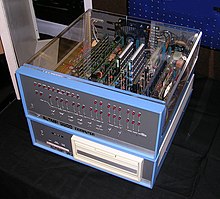
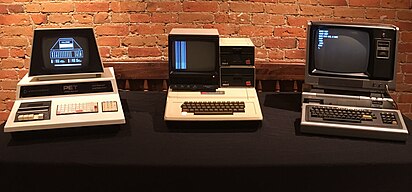


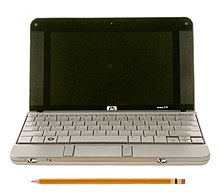


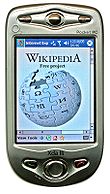

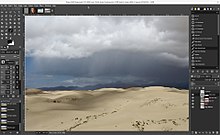




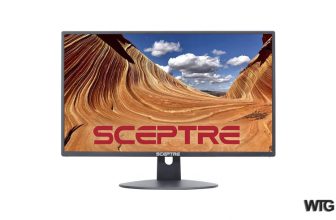

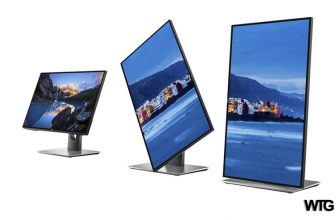

Cisco Servers are best servers, best wishes
[…] Best ViewSonic Monitor 2023 […]
[…] Best ViewSonic Monitor 2023 […]
[…] Best ViewSonic Monitor 2023 […]
[…] Best ViewSonic Monitor 2023 […]
[…] Best ViewSonic Monitor 2023 […]
[…] Best ViewSonic Monitor 2023 […]
[…] Best ViewSonic Monitor 2023 […]
[…] Best ViewSonic Monitor 2023 […]
[…] Best ViewSonic Monitor 2023 […]
[…] Best ViewSonic Monitor 2023 […]
[…] Best ViewSonic Monitor 2023 […]
[…] Best ViewSonic Monitor 2023 […]
[…] Best ViewSonic Monitor 2023 […]
[…] Best ViewSonic Monitor 2023 […]
[…] Best ViewSonic Monitor 2023 […]